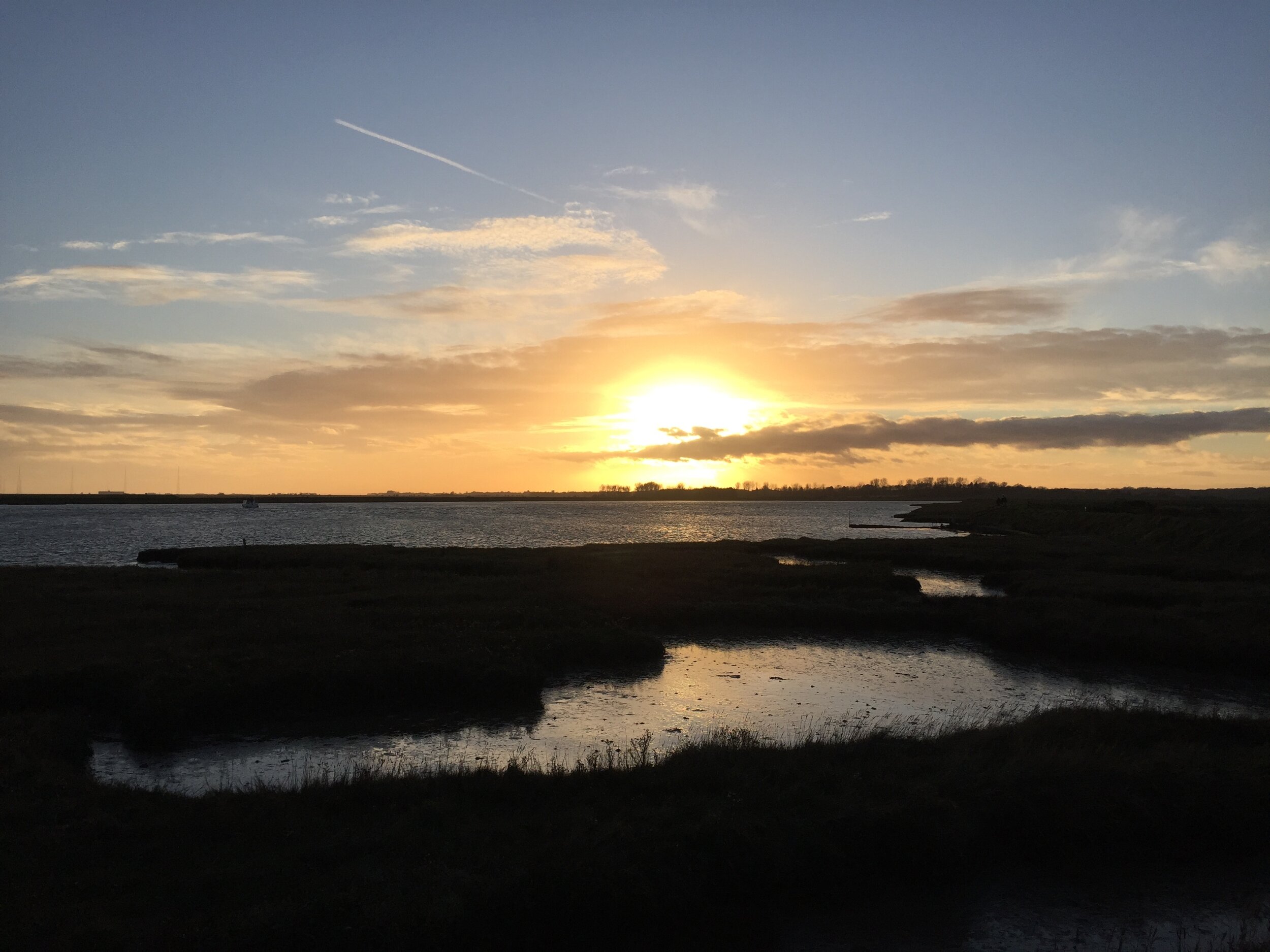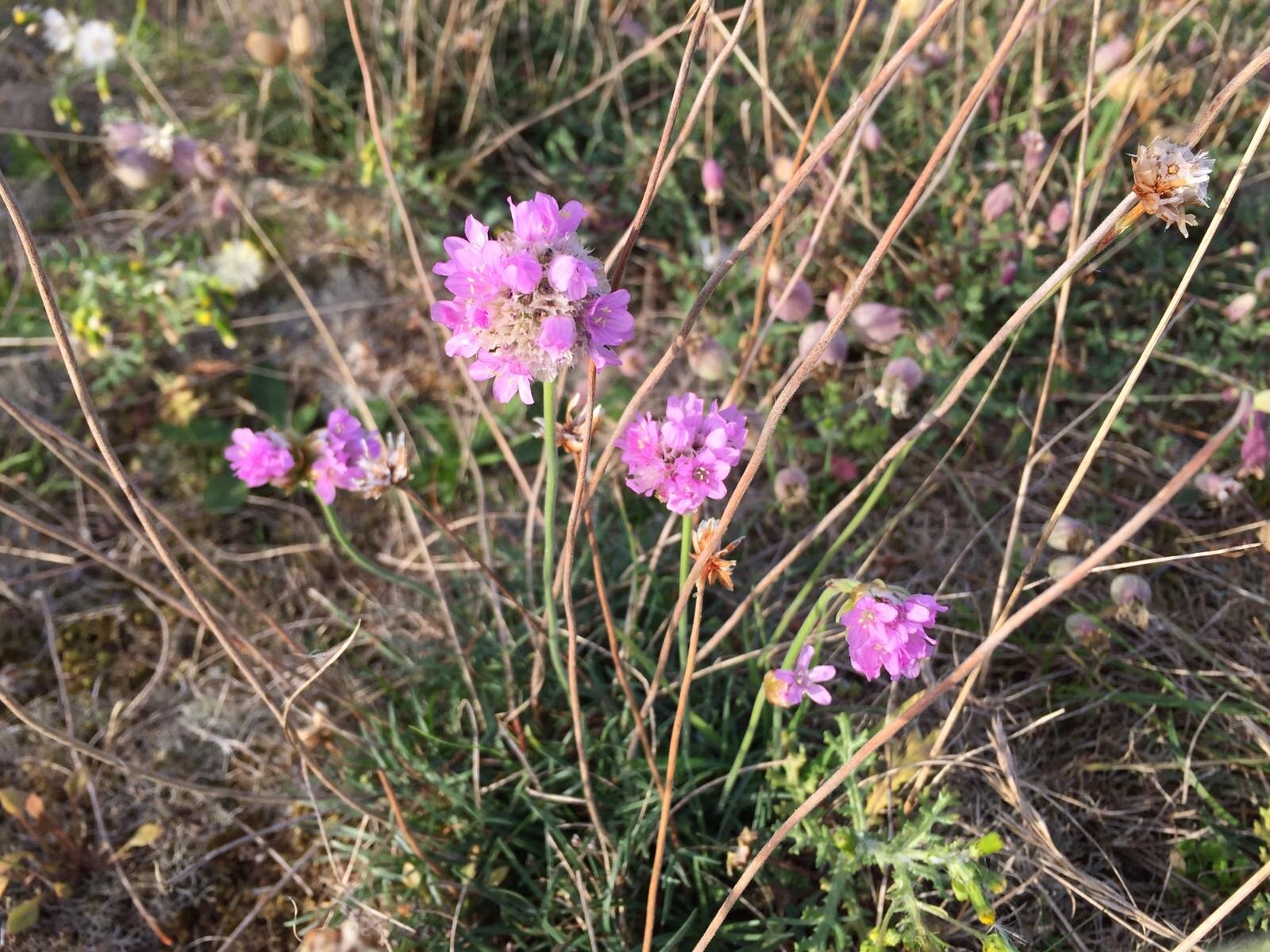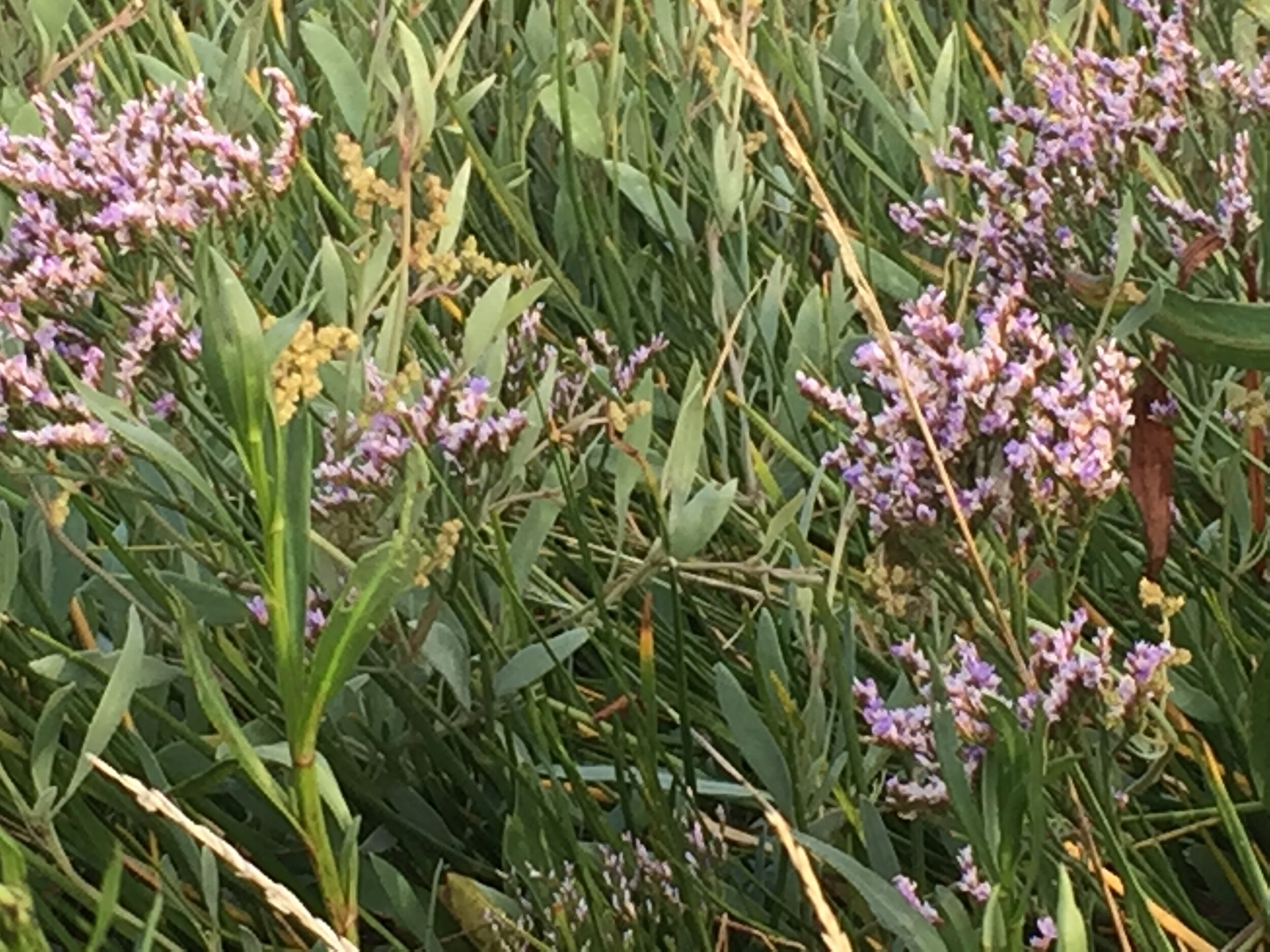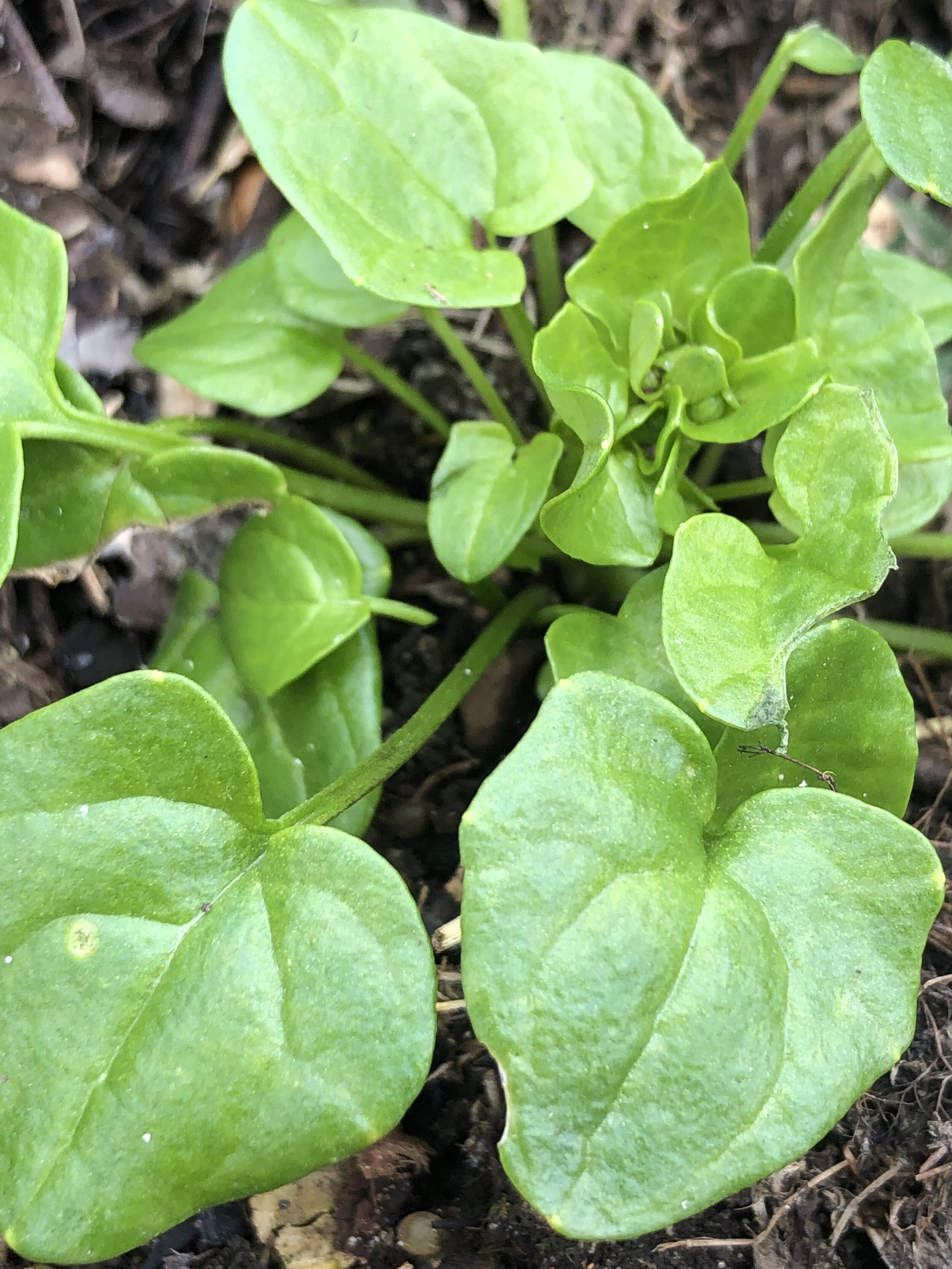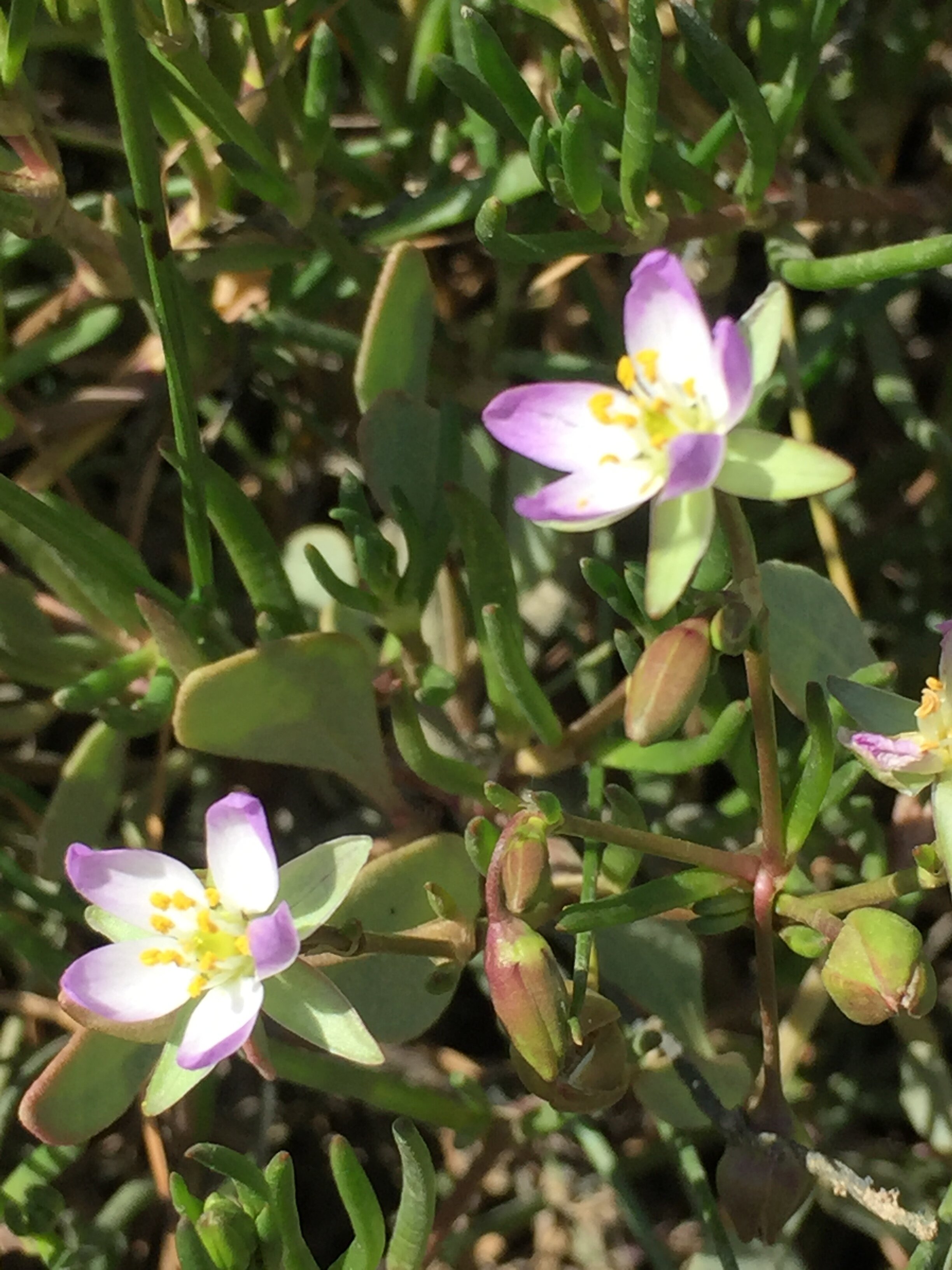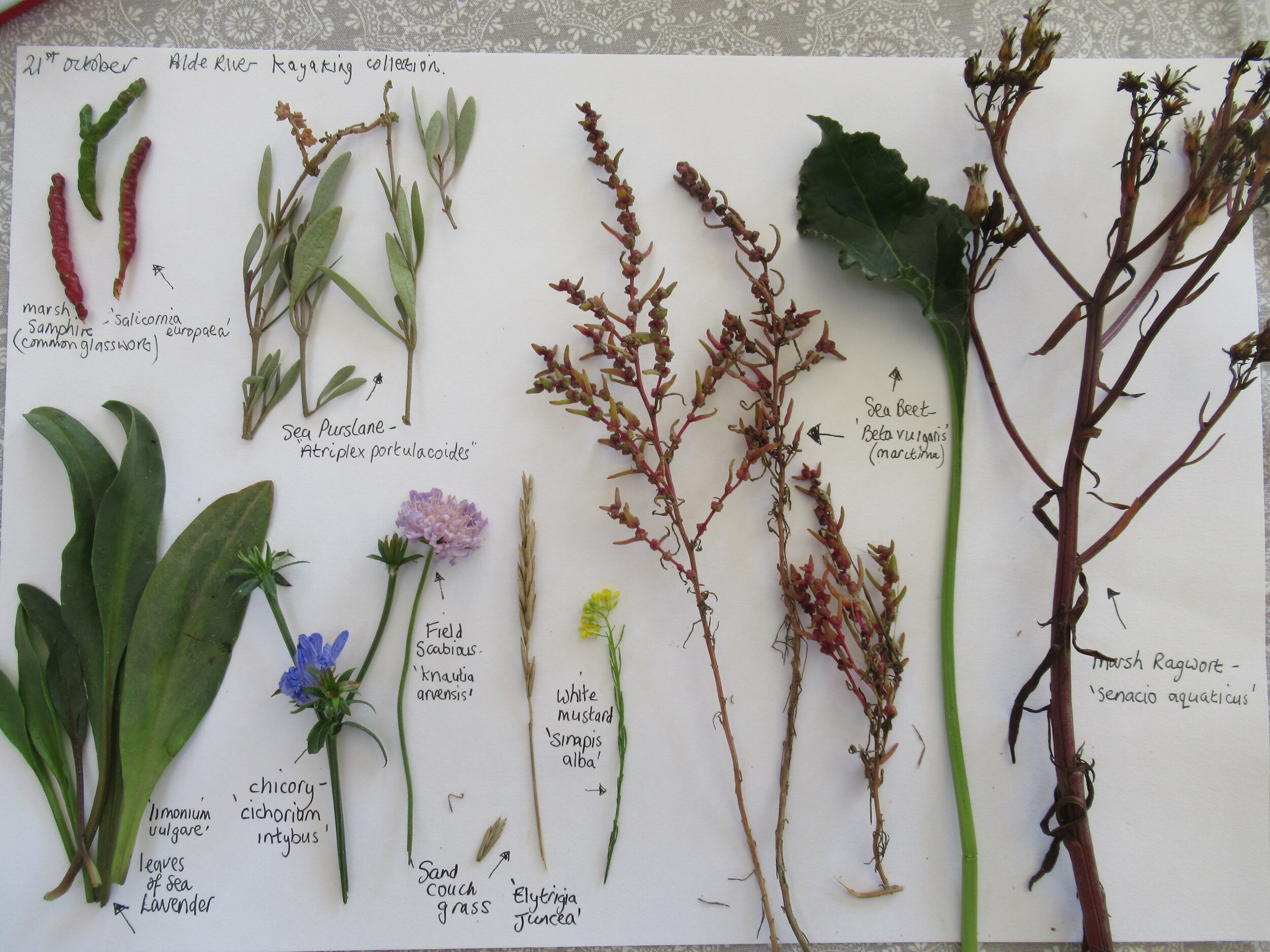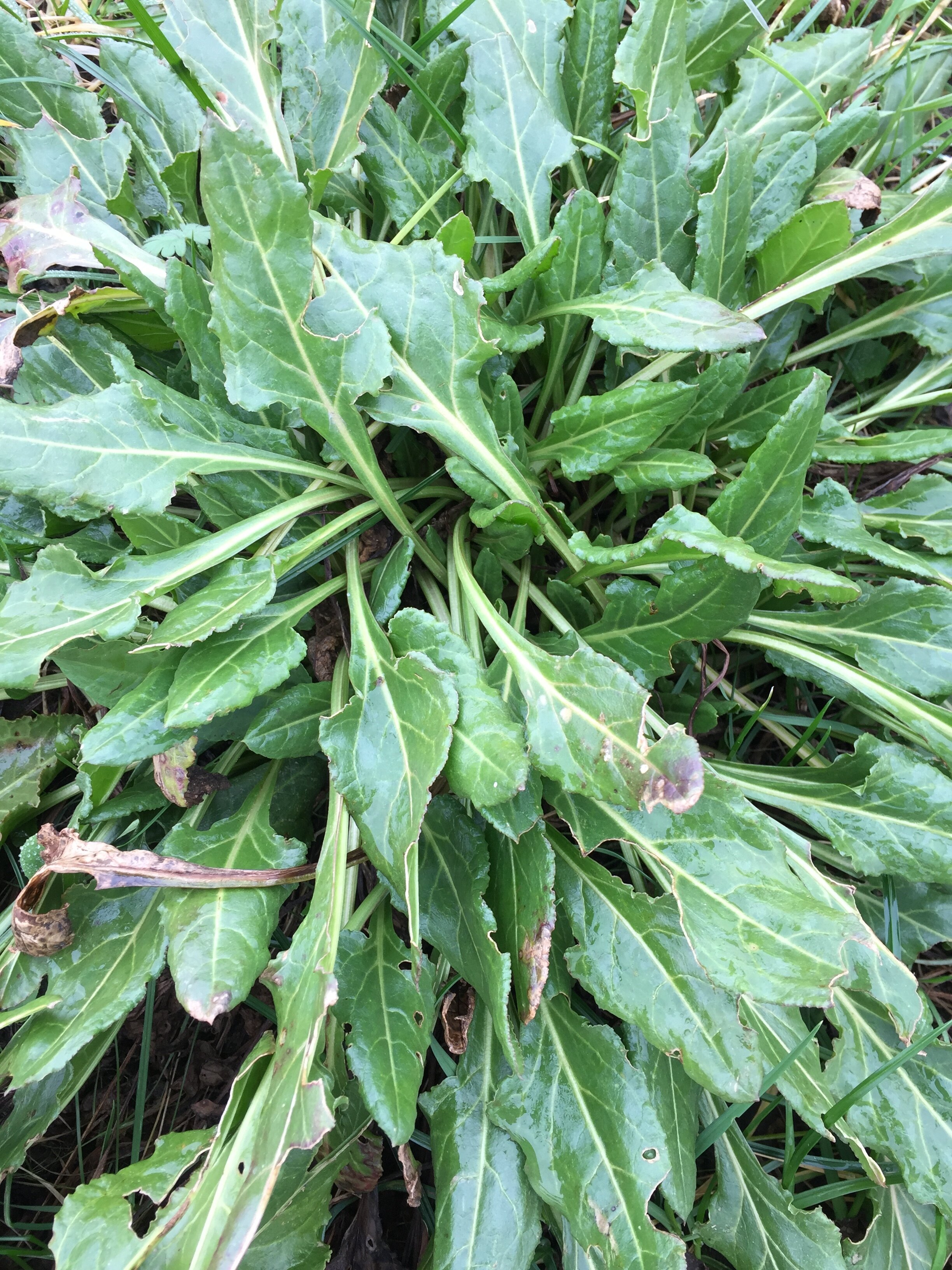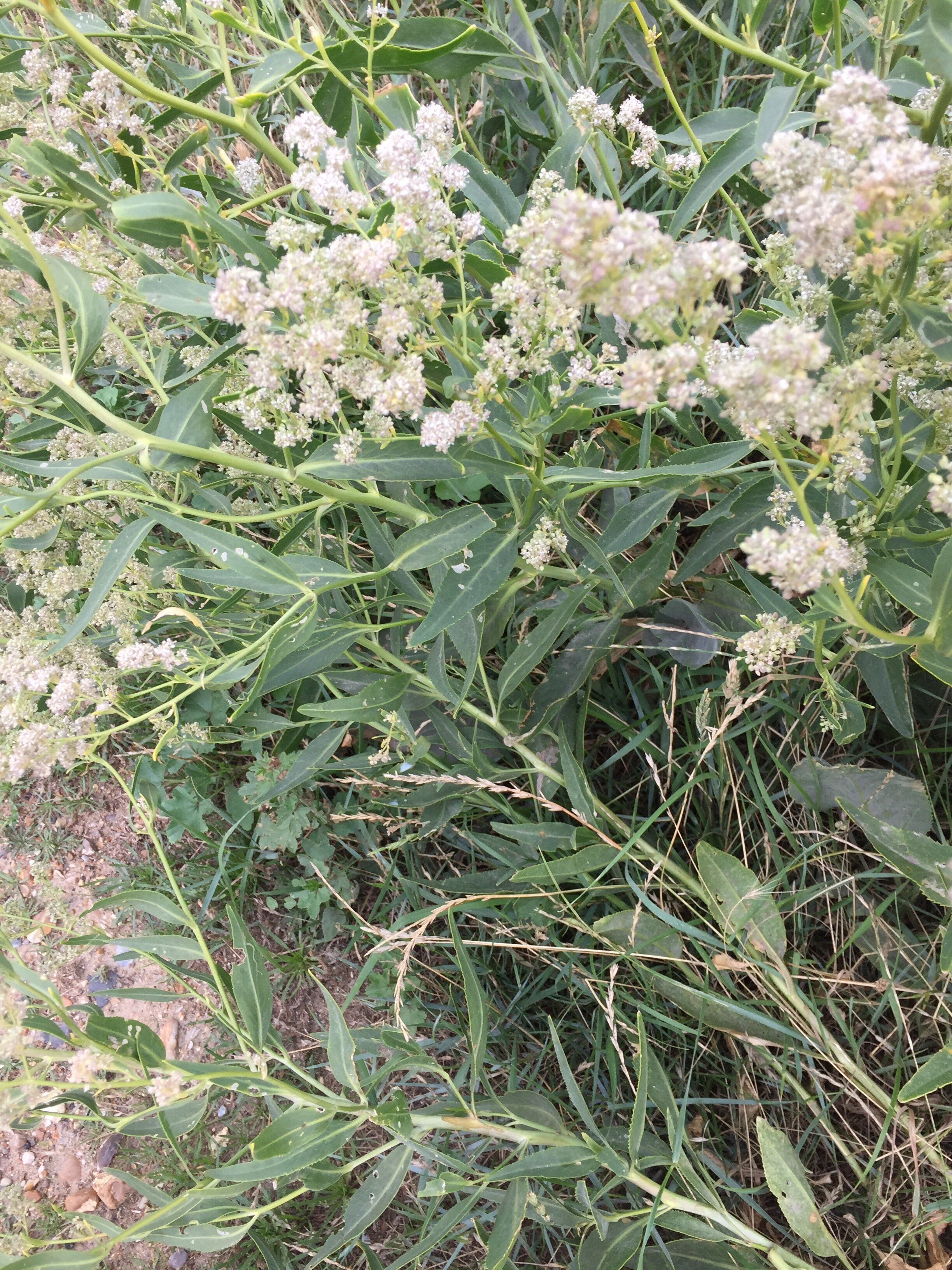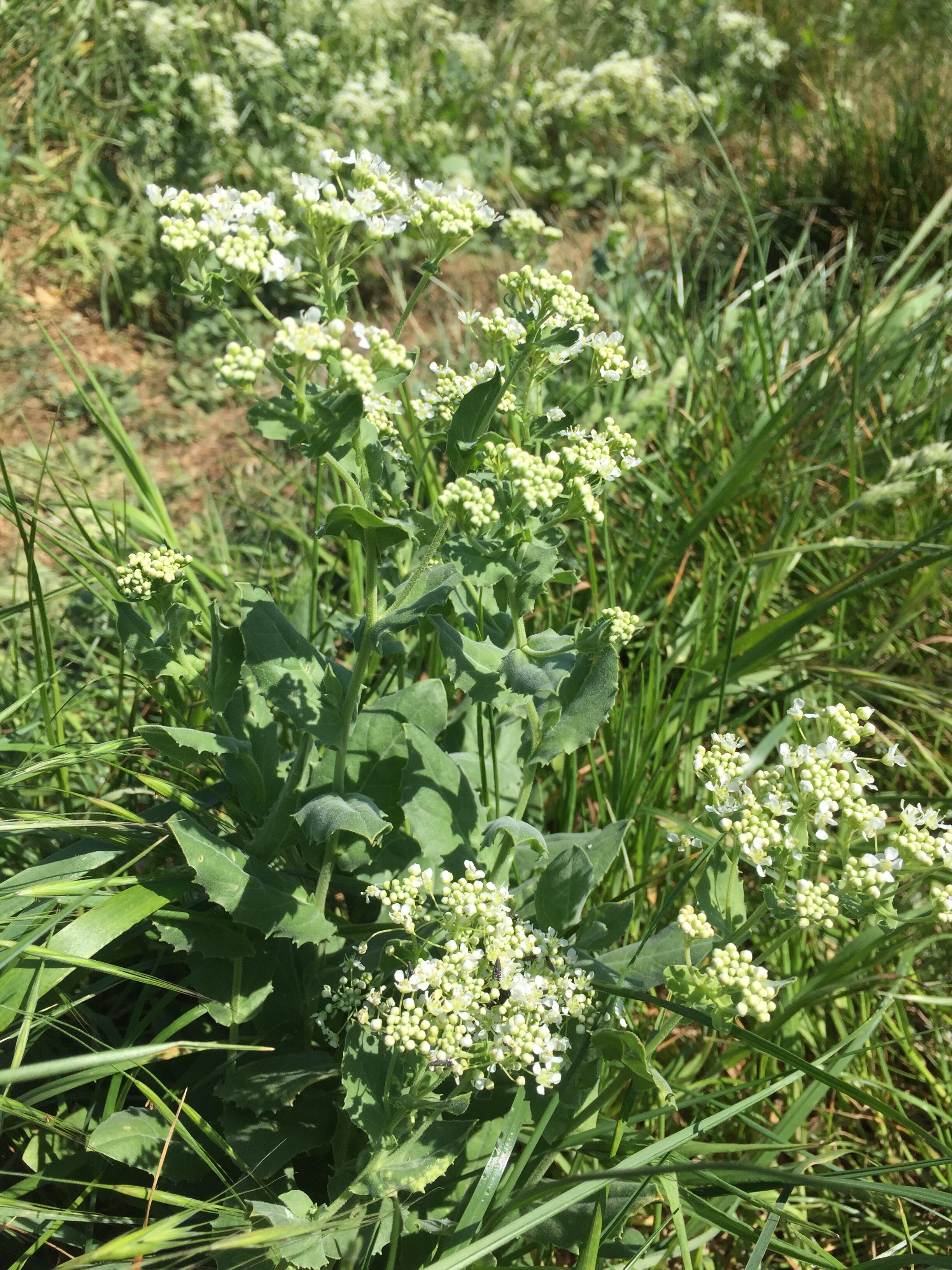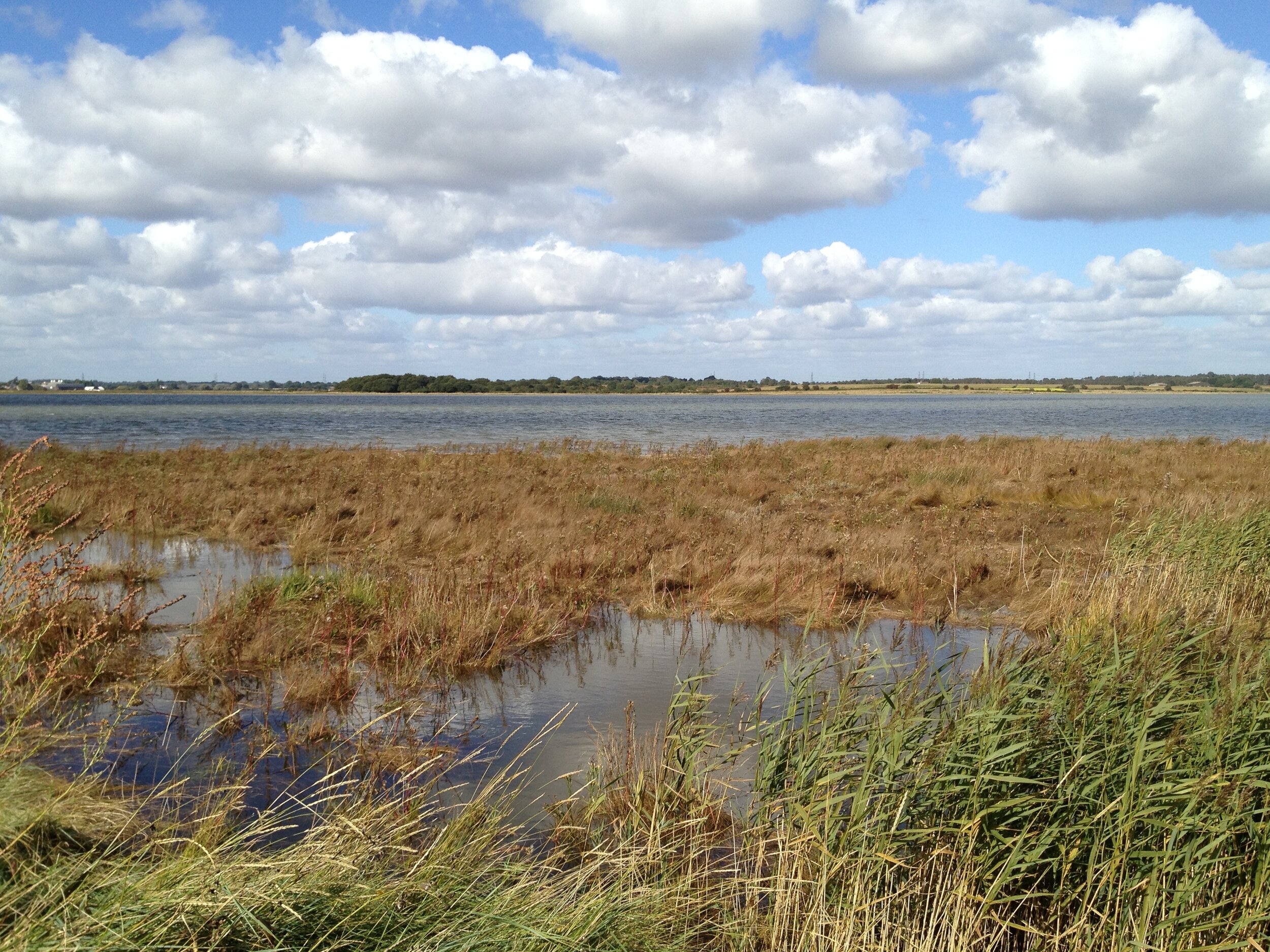Salt marsh plants of East Coast Rivers and Estuaries
Kayaking on the river Alde beyond Slaughden, between Brick Dock and Iken cliffs, is an immersive experience for all of the senses. At high water much of the saltmarsh is submerged enough to meander through the tiny shallow creeks and waterways formed by the ebbing and flowing river tide. The crowns of the marsh herbs are enveloped by salt water and some plants are totally submerged. As the water recedes, deep, smooth, silt-lined grooves are exposed between a myriad of saltmarsh islets.
As described by The Wildflower Key - Salt marsh vegetation is that of the zone between low and high tide marks on flat, muddy or sandy substrates in sheltered places, along estuaries or behind beaches and thus protected from the wave action of the sea. The plant species are determined at each level by the length of time and frequency of which they are covered or washed by the seawater.
Drifting through the narrowly winding rivulets with the top of the tide we’re naturally channelled through with the water at a gentle speed, allowing us to sit back and quietly enjoy the scenery. A lightly outstretched paddle neatly anchors the kayak to the bank for a closer look at plants and wildlife. It is an unexpected wonder to experience this environment at water level. The shy marsh birds barely notice our presence and the odd seal continues to bask on its sheltered, grassy glade in the sunshine – ready to launch in a nanosecond, slipping effortlessly from the mud ledge into the salt stream. Captivated, we continue to glide past, delighted at the Sea lavender, examining the sedges and Sea purslane. The seal pops up beside us wanting to play as we swish our hands in the muddy saline water.
Bladderwrack (Fucus vesiculosis)
Many plants show the obvious signs of adaption to salt tolerance; glaucus, fleshy foliage, reddish stems, thick new leaves and sturdy coarse stems, or low trailing habits and rhizomatous roots to help bind them to the mud or sand substrate. Seeds are poised, prepared for perfect wind and/or saltwater dispersal. The plants are able to withstand high levels of salt within their cell sap which enables them to absorb water via osmosis even when the external salt concentration is high. These adaptions enable plants of this environment not only to cope with sun and saline intensity, but to thrive, becoming established colonies.
The water is murky in colour, yet silky to the touch – a silt smooth solution. The seaweed is not diverse or pristine here, often dislodged from its anchor to be swept up and down this fast flowing tideway twice a day for most of its life. However, the medicinal and commonly known seaweed Bladderwrack (Fucus vesiculosis) also known as Black tang, can be found on the river in harvestable abundance. Wash and dry the seaweed and once dried it can be ground to powder for use in food or topical applications.
After the momentary slack waters of the top of the tide and as the ebb increases, mud begins to emerge. Glistening as the water retreats, we witness the revealing of a fresh array of Halophytic marsh plants.
LOWER REACHES: GLASSWORT, SEA PURSLANE, SEA CORDGRASS, BLADDERWRACK, ANNUAL SEABLITE.
Marsh samphire (Salicornia europaea)
Marsh samphire or Glasswort (Salicornia europaea) is found extensively at low tides within the lower reaches and, well known for its edible qualities, is gathered seasonally by locals. Wash and blanch the fresh new tips for a tasty addition to eggs or pasta. The fishermen sell it as an accompaniment to locally caught fish. In Norfolk ethnobotanists have recorded the past use of Marsh samphire as an ointment for cracked skin.
Each individual marsh samphire plant uproots easily so it’s a good idea to take a pair of scissors to cut the tips without damaging the rest of the plant. We nip the tops between thumbnail and forefinger. This plant is an annual, later in the season the growth slows and it becomes less tender to eat.
Sea Purslane (Atriplex - Halimione portulacoides)
An abundant perennial edible herb found on saltmarshes, Sea purslane is easily recognisable as a short, woody shrub of distinctive pale, grey-green foliage and densely fleshy, spoon-shaped evergreen leaves. The flowers are tiny and yellowish, also in dense branched clusters and occur from July to October. It forms in swards along the east coast creeks inhabiting well drained lower to upper saltmarsh areas. Sea purslane is the same family as Orache and it is the edible Spear leaved Orache (Atriplex prostrata) which can also be found in similar habitat. Often Identified by the familiar diamond shaped leaves, Atriplex is a large family (there are 10 species) of annuals often found on the coastal strandline and resembling Goosefoots (of the genus Chenopodium of which there are 12 species eg: Fat Hen and Good King Henry).
Sea purlsane (Atriplex - Halimione portulacoides) along the river bank
MIDDLE REACHES: THRIFT, SCURVYGRASS, SEA LAVENDER, SEA SPURREY, SEA COUCHGRASS, SEA ASTER
Casting across to the middle tidal reaches of the saltmarsh, delicate pink swathes of Thrift (Armeria maritima) dance lightly over the marshes stilling our gaze. The scent is honey. This beloved herb, also known as ‘Sea Pink’ and ‘Sea Gill o’ flower’, is described in folk tradition as medicinal in the Orkney Islands and Outer Hebrides. The tuberous roots were sliced and boiled in sweet milk to produce a drink known as ‘Arby’ as a remedy (circa 1700) for tuberculosis. Flowering in May and June and often later – the usually pink flower heads can sometimes be white. To identify Thrift in wintertime try looking out for slightly crimson leaves at the plant base to distinguish this plant from marsh grass.
Many saltmarsh plants flower in late summer and autumn.
An exception is English Scurvygrass (Cochlearia sp.) ‘ Spoonwort’- This herb is one of the first to flower - anytime from April through to June, with pretty white clusters of tiny flowers on stems. The stems can be redder and leaves darker depending on its habitat. The base Leaves form a loose rosette. The plant height is about 10cm. Rich in vitamin C, Scurvy grass is a well-documented edible, antiscorbutic herb. It is fun to be able to identify this plant within our local environment, taking a moment to linger over recollections of the historical reference. Additionally, there are descriptions of a Kentish folk remedy - Scurvy grass was gathered and prepared as a spring cleansing drink.
Sea Lavender (Limonium vulgare) Also known as ‘Marsh lavender’ and ‘Marsh Rosemary’ is a perennial maritime plant with a large root and liminal leaves in easily recognisable, familiar tufts. The flowers are pale bluish purple, and disappointingly, Sea lavender lacks smell. There are various folk remedies described for the use of sea Lavender. Gerard suggests the seeds to be ‘employed against colic, dysentery, strangury and fluxes of the blood’, M. Grieve says the only part used was the root and describes ‘various domestic remedies for its application as dried powdered root’.
Sea lavender is a common East Anglian saltmarsh inhabitant. During July and August look for an eye-catching, hazy, meadow-like swathe of lilac flowers clustered on woody stems.
Greater and Lesser sea spurrey – (Spergularia media & S.marina) nestles on the marsh hiding within the grasses. Greater sea spurrey grows up to 30cm height and is white or pink flowered or both (see photo). Lesser sea spurrey is smaller and the flower is distinguishable by its deeper pink colour. A delight to discover amongst the marsh plants, both Sea spurreys are edible and they flower between June and September.
Sea Aster (Aster tripolium) – Daisy & Dandelion family. Common names are ‘Blue Chamomile’, ‘Blue Daisy’. With its familiar, composite, daisy-like purple blue flowers and edible leaf, Sea Aster is often referred to as Michaelmas daisy (although the true Michaelmas Daisy -Aster novi-belgii – is taller, not fleshy leaved and has more ‘showy’ flowerheads). Sea Aster occurs often in colonies on saltmarsh rivers. It grows in mud but also in the meadows and is found commonly anywhere between the lower marsh and the upper most strand lines of the River Alde. Usually flowering from July to October, I’ve found it still in flower in early December, pretty much the last flowers on the marsh. Gerard describes the root as a wound herb.
Sea Couch Grass (Elytrigia atherica)
Sea Couch grass (Elytrigia atherica). A common rigid stemmed grey green rough edged grass found on the upper and middle levels of saltmarsh. The leaf is ribbed on the upper side and sharp pointed. The flowers appear from July to September and the familiar fan shaped couch grass spikelet is easily recognisable. Gather the plant with the root and make a liquid plant feed in the same way you’d use the Stinging Nettle whole plant as garden and vegetable organic fertilizer. Common Couch grass (Triticum -Agropyron repens) is used considerably as an herbal medicine. The rhizome roots are harvested in spring and dried for later use.
UPPER REACHES: SEA BEET, DITTANDER, HOARY CRESS, ORACHE
Many more species thrive along the banks of the saltmarsh estuaries. They are growing above the highwater mark but are constantly subjected to salt air and spray and also are percolated saline water from below.
Sea Beet (Beta vulgaris ssp maritima) Also known as wild or sea spinach. Sea Beet is an edible herb, common around the coastline and found in the upper levels of saltmarsh habitats. This perennial species is the ancestor of our cultivated beets and spinach. The growth is sprawling and the lower stems have red stripes on them. Pick the large fleshy base leaves and thinner smaller spear shaped leaves nearer the head of the stem, and wash and cook the leaves before eating. Ideally gather from this rather untidy plant with upright growth habit, between April and October. Salt tolerance exhibits itself in the thick shiny hairless leathery leaves with wavy edges. The tiny green blooms on long leafy spikes flower between June and September and are wind pollinated. The green fleshy shiny base leaves often over winter whilst the stems turn brown and die back during autumn.
Dittander (Lepidium latifolium) Cabbage family also known as ‘Pepperwort’, ‘Peppergrass’ is found naturally mainly in south east England and East Anglia. However, Dittander is increasingly cultivated as a culinary and medicinal herb and escaping to be found in some inland locations. With its waxy pale green leaves and long roots Dittander is a typical upper reaches saltmarsh herb, adapted to survive harsh saline environments. With a peppery flavour (hence the common names), this perennial plant is tall with each stem growing up to 1.5m with panicles of tiny white flowers from June to September. The traditional use of Dittander has now been replaced by Horseradish.
An historical folk traditional remedy described by John Parkinson – an apothecary of London in the 1600’s - ‘the woman of Bury st. Edmunds in Suffolk doe usually give the juice thereof in ale to drinke to women with child to procure them a speedy delivery’.
Hoary Cress (Cardaria draba) is in the Cabbage family. Not a native and can be invasive, Hoary Cress was introduced in early 1800. Neither a saltmarsh herb as such however it is found locally and is common on sandy shores and estuaries in addition to wasteland, verges and arable fields. On the edges of the Alde it grows beyond the high tide mark, by creeping rhizome, amongst the tall grass and by the river wall footpaths. A member of the cabbage family, Hoary cress is patch forming and flowers in may and June in clumps of densely clustered white flower heads on grey green upright stems of approx. 20cm high.
Alongside the patches Hoary Cress, there are other sun loving herbs in the summer time such as Scabious, Chicory, Wild Carrot and Black, White and Hedge Mustards.
The plants described here give an idea of the multi-layered variety of species that occupy this intriguing environment and are a good indication of what species you may come across, even by walking along the paths of the east coast rivers. Taking a Wildflower key for identification and a pair of binoculars helps but is no means necessary to enjoy the biodiversity of these natural wildlife places.
The Coasts and river estuaries are often good places to look for wild flowers. All wild flowers are precious and fragile even where they appear in abundance or are described as ‘weeds’. It is worth identifying even the common plants – which can be just as beautiful and rewarding - observing their characteristics for similarities and their preferred habitats. Noticing where colonies are established is a significant step towards building local conservation. Although many of the saltmarsh herbs are edible, always check the ID and the nutritional (including methods of preparation) and conservation status before gathering these plants – and be aware of potential contaminants.
Follow our herb trips via instagram @herberandco or join us this spring and summer on a kayak-foraging experience. All are welcome.

